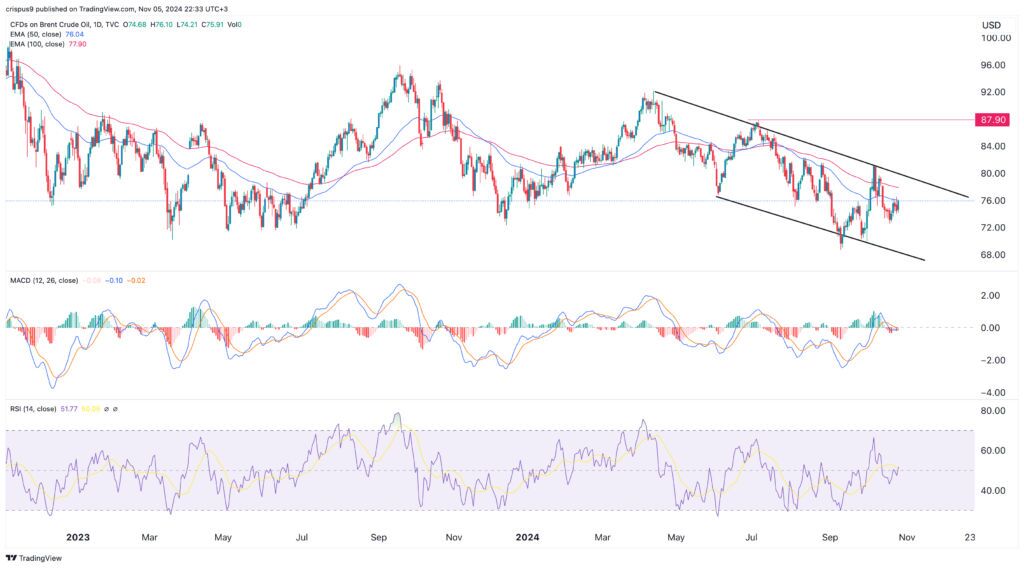Brent Crude Oil Forecast: Downward Trend To Remain Intact
Image Source: Unsplash
Crude oil price held steady on Tuesday as investors’ focus remain fixated on the US presidential elections. In the previous session, WTI futures rallied by over 2% to an intraday high of $71.81 as the market reacted to OPEC+ decision to delay increasing production in December.
This is the most the asset has risen in a day in over three weeks. In addition to these key events, risk-taking will likely remain limited throughout the week as markets also eye the Fed policy meeting and China legislators’ meeting.
Since late June, the benchmark for US oil has been down by close to 15% following Americas’ surge in supply. Besides, demand from the leading importer and second-largest consumer of oil has been rather disappointing.
OPEC’s production
On Sunday, the Organization of the Petroleum Exporting Countries together with Russia and other allies (OPEC+) announced its decision to push the expected output increase in December by one month.
Notably, this is the second time that the organization is pausing on pumping more oil barrels into the market. In June, OPEC+ indicated that it would raise production by about 2% of the global supply, equating to 2.2 million bpd, in October. However, in September, it decided to delay the surge in production till December.
At the core of the crude oil market are the fundamentals; the demand and supply forces. In recent months, the demand and supply dynamics have been shaped by tension in the Middle East, Americas’ surge in supplies, and lower demand from a key importer and consumer – China. Besides, all eyes are on the tightly contested US presidential elections.
Besides, OPEC+ and the broader oil market is still keen on the geopolitical tensions in the Middle East. One of its member -Iran – remains in conflict with Israel. On Saturday, Iran’s supreme leader, Ayatollah Ali Khamenei stated the country’s enemies, including Israel and the US “will definitely receive a crushing response to what they are doing to Iran, the Iranian people, and the resistance front.”
There are heightened fears that Iran is considering whether and how to respond to the attack by the Israeli forces in October. Israel’s move was in retaliation to Iran’s missile attack that occured following the killing of Hamas and Hezbollah leaders.
With all these influential drivers, it makes sense for OPEC+ to maintain its voluntary cuts at least for another month. The alliance is now set to meet on 1st December to deliberate on the 2025 output policy.
China’s oil demand
China’s sluggish economy and the subsequent decline in its oil demand growth remains one of the key concerns for investors in the global market. As the second-largest consumer of oil and top importer of the commodity worldwide, it plays a crucial role in shaping the demand-supply dynamics.
In September, the International Energy Agency acknowledged that the slowing of Asia’s leading economy has caused the global oil consumption to slow sharply.
Similarly, OPEC lowered its forecast for the year’s oil demand growth for the third consecutive month. The organization now expects global consumption to rise by 1.9 million bpd; 106,000 bpd lower than previously forecast.
At the same time, investors are eyeing the outcome of the US presidential election vs. China’s fiscal stimulus. Some see the presidential results as a influential factor as the markets await an announcement of any fresh stimulus measures from the National People’s Congress on Friday. This follows the five-day legislators meeting that commenced on Monday.
During his campaign, Trump threatened to increase tariffs on China’s exports to the US by 60%. As such, a Trump win may prompt China to present a higher stimulus package with more focus on the domestic market.
Brent crude oil price forecast
(Click on image to enlarge)

The daily chart shows that the price of crude oil has been in a downward trend. It has formed a descending channel shown in black. It remains below the 50-day and 100-day moving averages, meaning that bears are in control.
The MACD indicator has remained at the neutral level, while the Relative Strength Index (RSI) has moved to 50. Therefore, the path of the least resistance for crude oil is bearish, with the next point to watch being at $68, the lower side of the descending channel.
The bearish view will be invalidated if it moves above the upper side of the channel at $80. If this happens, it could rebound to $87.90, its highest level on July 8.
More By This Author:
EUR/USD Forex Signal: More Volatility Ahead Of US Election And Fed
Copper Price Forecast: U.S. Election, China Stimulus In Focus
AUD/USD Forex Signal: Bearish Outlook Ahead Of RBA Decision
Disclosure: Invezz is a place where people can find reliable, unbiased information about finance, trading, and investing – but we do not offer financial advice and users should always ...
more



